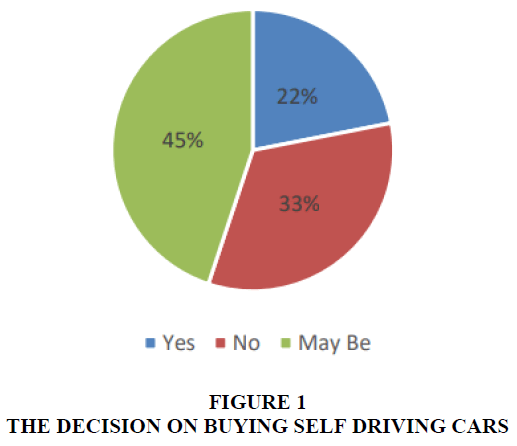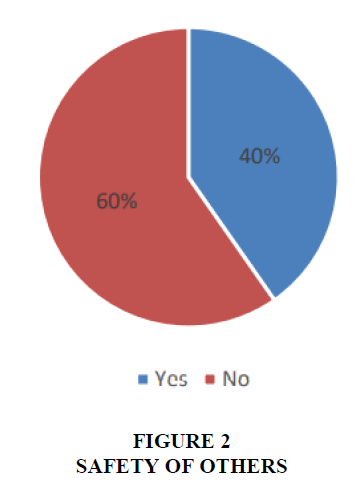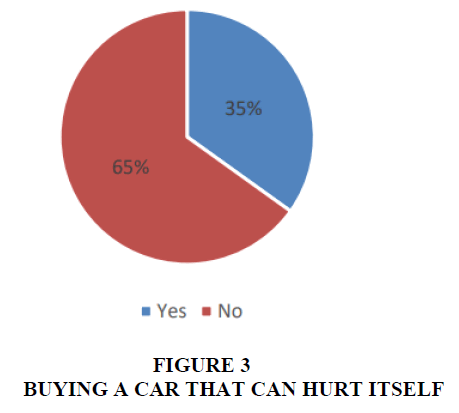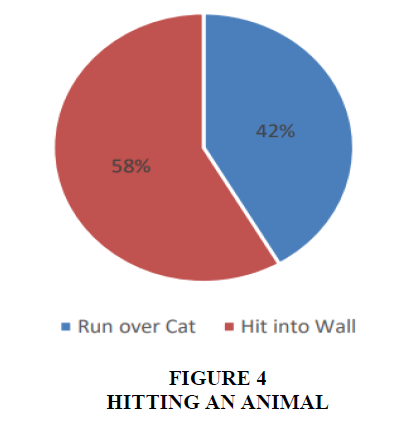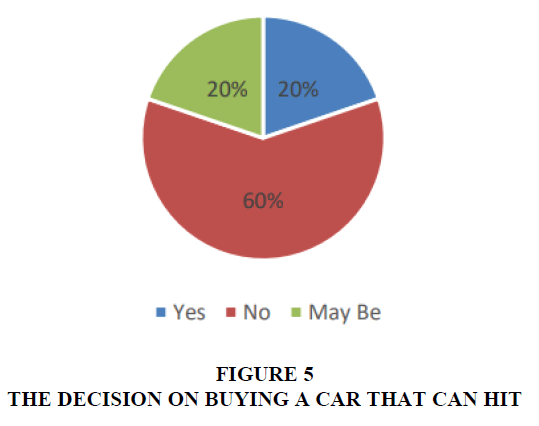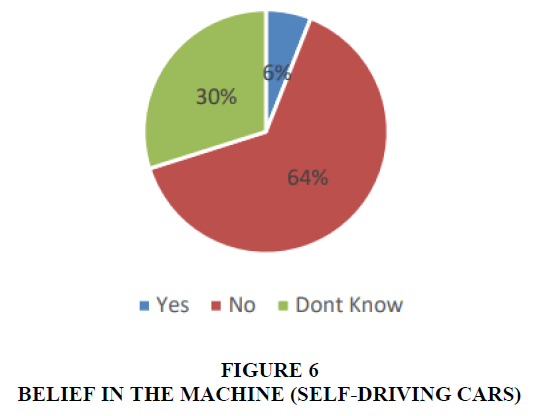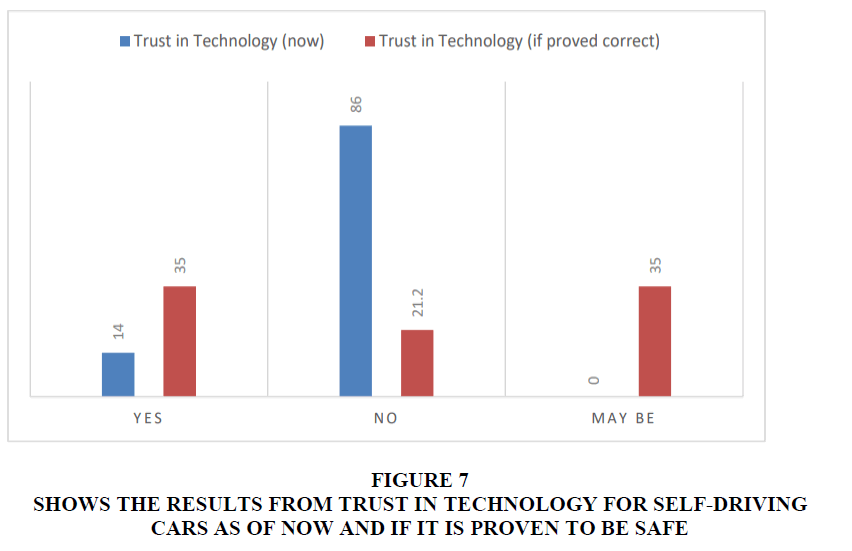Research Article: 2020 Vol: 23 Issue: 6
Ethical View of Self-Driving Automobiles
Yasir Javed, Prince Sultan University
Shafiqul Hassan, Prince Sultan University
Shabir Hussain Khahro, Prince Sultan University
Tauha Hussain Ali, Mehran University of Engineering & Technology
Abstract
The current era is also classified as automation era of the information age where most of the daily life activities are becoming self-done. Robotics, 4G+, 5G and IoT are one of the major reasons for this transformation. One of modern era transformation technology is self-driving cars that classify as a driver-lesser car; they can be self-controlled and driven over busy highways such as Google car or Tesla. These automated cars have also raised numerous ethical questions such as the decision to do the crash or hit someone. Another question is whether it is ethical to produce or use self-driving cars? This research aims to find the answer to this question by conducting a survey among various countries and through both genders. Analysis of results has been conducted using two principles of ethics which are: Kantianism first formulation and Act utilitarianism. It is the observer that the majority of people want to buy selfdriving cars yet they are aware of the issues that may arise while using automated cars. It is also observed that most of the users consider driver life is important and people will be reluctant to buy a car that might pose a threat to them.
Keywords
Self-driving cars, Ethical Theories, Programmed Vehicle.
Introduction
Who thought that there will come a day that technology takes over our lives? Day by day technology is becoming something essential rather than a complementary. It is right that there are no cars that fly like in the 90s movies yet, but cars without drivers are nowhere. There was a scene in the famous movie I-Robot which was published in 2004 showing the lead actor using the self-driving car in 2035 (Broadbent et al., 2010). As of today, there are autonomous cars are on the roads and being tested widely even commercially. Self-driving cars will ease up the life of travel and will also reduce the number of accidents that are usually caused due to driving fatigue or sleeping. Self-driving cars are one of top-trending to-be must-have among all ages but mostly among youngsters.
A report was published by Business Insider saying that in 2020, it is expected to have 10 million self-driving cars on the roads (Jones, 2016). Several issues may be raised due to autonomous cars as they rely on sharing information and identity. These autonomous cars tend to take decision such as: (1) in case of kids crossing the road while brakes cannot be applied what should be done (2) hitting one person compared to hitting wall or hitting group of people (3) Can driver pay for a program to hit the driver in worst-case scenarios. This research discussed the ethical issues of producing or using self-driving cars by discussing their pros and cons and judging the result using: Kantianism first formulation, Act utilitarianism and rule utilitarianism ethics principles (Altman, 2014).
Literature Review
Self-driving cars hold the feature of safety in vehicles. Yet, they are not 100% safe. This is because these cars are not programmed to expect pedestrians or human drivers to jump surprisingly (Nyholm & Smids, 2018; Goodall, 2014). Due to this fact, self-driving cars should be programmed differently to cater to all possible scenarios to react to unavoidable accidents. These problems raise an ethical question such as protecting most lives or always protect its passengers. Philosophers have talked a lot about what they call "Trolley problem". This problem says what if the car only option to save 4 lives was to kill one (Bonnefon et al., 2019). What would the car choose? Patrick Lin considering in its most iconic thought-experiments in ethics is the trolley problem. And this is one that may now occur in the real world if autonomous vehicles come to be (Cunneen et al., 2019). The easiest way to introduce the Trolley problem is by giving a scenario example, let's assume that there is a driverless trolley going towards 4 people who are stuck on the truck and the only way to avoid killing them was to redirect the trolley to a side track which happened to have one man standing on. What are the right and ethical thing to do? Most responses were to switch the trolley and save many lives (Loh, 2019; Sommaggio & Marchiori, 2020; Nyholm & Smids, 2016; Jaiswal, 2017; Koubâa, 2018).
Transportation via car in the United States is turning out to be progressively unsustainable. Rising carbon gases, congestion, and high car crash rates are a couple of outcomes of automobile use. It is claimed that self-driving cars provide solutions to several pollution solutions (Li et al., 2015; Stone, et al., 2020). Self-driving cars offer a higher rate of safety and sustainability and it can promise to reduce the percentage of crowded roads (Kohl, 2018). It is shown that only 35000 deaths that were caused by traffic accidents in 2010 only in California (Howard & Dai, 2014). Research on connected vehicles has shown that vehicle-to-vehicle communication system potentially addresses 81% of all police-reported vehicle target crashes annually (Howard & Dai, 2014; Filatov et al., 2019). It is one of the supporting arguments for self-driving cars. Studies show that people will be buying self-driving cars by considering in first place if they are safe or not (Faulhaber, 2019). From that will ethical questions can arise, can self-driving cars always provide the safety needed for its passengers while doing the right ethical decision? (Stephen, 2019) For example, we go back to the trolley problem, should a car save its passengers on all costs or should it be programmed on saving as many lives as it can? (Simons, 2020; Hancock, 2019). Goodall (2014), Simons (2020), Ali et al. (2019), emphasis that autonomous vehicles can be pre-programmed for taking the right ethical decisions when needed, but they need a lot more work than the actual current work.
Research Methodology
This research used a Google-based survey containing the questions shown in Table 1. All of the 13 question are linked to self-driving car issues along with little basic information. The survey was distributed through web links, WhatsApp groups and education links from authors as well as faculty members and students of Prince Sultan University.
| Table 1 Showing a List Of Question for Finding Perception of Self-Driving Cars | |
| Questions | Would you buy a self-driving car? |
| If you were told that this car is programmed to save as many lives as possible, In other words, if 4 people were crossing the street and the car had only 1 one passenger, the car will save the 4 people crossing the street because they are more in number. Even if that means causing serious injuries for the passenger, would you agree on buying it? | |
| If the opposite, the car will protect the passenger regardless of the damage it may cause to the people crossing the street, would you still buy it? | |
| If you were driving a normal car and a cat surprisingly jumped in front of you and the only | |
| way to avoid it is to smash into a wall what would you do? | |
| Would you buy a car that is programmed to always run over the cat instead of swerving into the wall? | |
| Would you buy a car that will always swerve into the wall in such a case? | |
| If three people jumped in front of the car and the only way to avoid them was to swerve into a man walking on the side of the street. Do you think that the car can always make the right decision? | |
| Do you believe technology can make critical choices for you? | |
| If a study was published saying that self-driving cars are safer than human driving, would you consider buying one? | |
| Basic Information such as Gender, Age, Job Title and Nationality. | |
The collected responses during March 2019 were 360 where 164 respondents were male (45.3%) and 196 respondents were females (54.7%). People who participated in this survey were from different countries that are 16 namely America, Benin, UK, Canada, Brazil, France, Indonesia, Syria, Saudi Arabia, Kuwait, Sudan, Yemen, Romania, Palestine, Jordan and Lebanon. While the majority of results are from the Middle East.
Survey and Result
The following Table 1 shows the questions which were asked during the survey.
Analysis and Discussion
The following section reflects on results of each question.
It is seen from (Figure 1) results that majorly people would plan to buy the self- driving car that shows the concern related to security or critical choices that have to be made along with self- driving cars. But the overall interest in buying a car is higher compared to 33% of non-interest in self-driving cars.
It is seen from (Figure 2) results this question was to see if the public is considered with the safety of others as considered with theirs. 80 out of 189 (42%) of the participant females answered with yes they would buy it. And almost 61 out of 164 (37%) of the male participants answered with yes. This shows that participants are concerned about the safety of others that is more in male. It is also clear that self-care is one of the important selecting criteria
It is seen from (Figure 3) results that majorly people would not buy the cars that can hurt the driver. 64(33%) of the females participated answered with yes. 56(34%) of males answered with yes. The result shows that the concern is similar to personal safety in male and female.
This question is just to see if people make a difference between lives (human life and animal life). The result shows that 58.5% would put their lives on the danger to save the life of the cat. Below you will find the percentage of people who said they will run over the cat based on their age: 0-17: 100%; 18-21: 47%; 21-28: 56%; 21-40: 33%; 40+: 32%
It can be noticed that the percentage varies in each age where youngsters would run over the cat while adults do care about the animal even (Figure 4).
The questions clarify old result where the concern was hitting a cat, but in actual people are not interested in buying a car that can hit an animal even a cat. Thus the programming of this autonomous car must be made under careful conditions to minimize the effect of hitting (Figure 5).
The belief in technology is very low as shown in the result that is only 6%. It shows a lack of trust in making the right decision and thus the decision can be verified by the driver but it will raise another concern such as a command to kill. Thus the supervision can be made under the strict rules with no command related to hitting a person intentionally (Figure 6).
Trust in Technology (Now and After)
It is seen from the results shown in Figure 7 that people did trust in technology deciding for them especially when it is related to hitting the wall or hitting the animals. It should be considered by the programmer of test cases to address the issues and concerns as clearly indicated in Figure 7 that the trust increases when it is proven that technology will take right decisions for the driver or any living thing outside. Discussion according to social and ethical theories:
Figure 7 Shows the Results from trust in Technology for Self-Driving Cars as of now and if it is Proven to be Safe
Kantianism
Proposed Rule: The auto-driving cars' company programmed its cars to run over the cat in the case if that would save humans getting injured.
Universalized Rule: Every autonomous cars company will program their cars the same way.
Result
The percentage of cats' deaths from accidents is going to increase a lot.
Act Utilitarianism
Good:
1. Fewer accidents
2. Less crowded streets
3. Economical (people who can't drive don’t have to take taxies each day anymore) 4- Efficient travel (the whole family could use one car).
4. 5- Better environment
Bad
1. Very expensive
2. Not reliable
3. Will cause a lot of drivers to go out of their jobs and even cause taxi captains to be unemployed.
4. Could cause kidnaps if the car got hacked. 5- Identity of a person can be easily revealed
Result
It is seen that benefits in terms of economical and impact on the environment are better thus it is recommended to use self-driving cars. It is also of utmost importance to address the security and legal concern before the public usage of these self-driving vehicles is launched.
Conclusion
Autonomous cars hold many promises to reduce the rate of accidents and increase safety standards. The problem is that it is less known that how the decision of these self-driving cars will impact the life of anyone on the road. It is also needed to consider all the legal as well as ethical issues related to autonomous cars as it will dictate the programming of these autonomous vehicles. A question of concern is that can a self-driving vehicle provide the highest safety rate for passengers and do the right ethical decisions at the same time? This research used a survey-based approach to ask people their opinion about self-driving cars and its decision that can impact driver or living thing. The results were compared using Kantianism and Act Utilitarianism theories. It is shown from results that self-driving car has a lot of benefits but ethical concern also surpasses the benefits and must be addressed. It can be done with proper testing and sharing the real-time results with the public to change their perception. It has also been observed that people lack trust in technology and to increase the trust in technology, proves have to be provided through rigorous experimentation and publishing the decision model according to various situations. This research also highlights privacy and identity issues while evaluating it through ethical theories and must also be addressed.
References
- Ali, N., Bonyadi, M.R., Raja, M.A., Akhtar, J., Javed, N., & Ryan, C. (2019). FUSCD-Future smart car driver. In 2019 22nd International Multitopic Conference (INMIC) (pp. 1-7).
- Altman, M.C. (2014). Kant and applied ethics: The uses and limits of Kant's practical philosophy. John Wiley & Sons.
- Bonnefon, J.F., Shariff, A., & Rahwan, I. (2019). The trolley, the bull bar, and why engineers should care about the ethics of autonomous cars. Proceedings of the IEEE, 107(3), 502-504.
- Broadbent, E., Kuo, I.H., Lee, Y.I., Rabindran, J., Kerse, N., Stafford, R., & MacDonald, B.A. (2010). Attitudes and reactions to a healthcare robot. Telemedicine and e-Health, 16(5), 608-613.
- Cunneen, M., Mullins, M., & Murphy, F. (2019). Autonomous vehicles and embedded artificial intelligence: The challenges of framing machine driving decisions. Applied Artificial Intelligence, 33(8), 706-731.
- Faulhaber, A.K., Dittmer, A., Blind, F., Wächter, M.A., Timm, S., Sütfeld, L.R., & König, P. (2019). Human decisions in moral dilemmas are largely described by utilitarianism: Virtual car driving study provides guidelines for autonomous driving vehicles. Science and engineering ethics, 25(2), 399-418.
- Filatov, A., Scanlon, J.M., Bruno, A., Danthurthi, S.S.K., & Fisher, J. (2019). Effects of innovation in automated vehicles on occupant compartment designs, evaluation, and safety: A review of public marketing, literature, and standards (No. 2019-01-1223). SAE Technical Paper.
- Goodall, N.J. (2014). Machine ethics and automated vehicles. In Road vehicle automation (pp. 93-102). Springer, Cham.
- Hancock, P.A., Nourbakhsh, I., & Stewart, J. (2019). On the future of transportation in an era of automated and autonomous vehicles. Proceedings of the National Academy of Sciences, 116(16), 7684-7691.
- Howard, D., & Dai, D. (2014). Public perceptions of self-driving cars: The case of Berkeley, California. In Transportation research board 93rd annual meeting (pp. 1-16).
- Jaiswal, S. (2017). Autonomous cars: An adaptable feedback mechanism for customised ethics.
- Jones, A. (2016). Autonomous cars: Navigating the patchwork of data privacy laws that could impact the industry. Catholic University Journal of Law and Technology, 25(1), 180-198.
- Kohl, C., Knigge, M., Baader, G., Böhm, M., & Krcmar, H. (2018). Anticipating acceptance of emerging technologies using twitter: the case of self-driving cars. Journal of Business Economics, 88(5), 617-642.
- Koubâa, A., Bennaceur, H., Chaari, I., Trigui, S., Ammar, A., Sriti, M.F & Javed, Y. (2018). Robot Path Planning and Cooperation. Springer International Publishing.
- Li, Q., Qiao, F., & Yu, L. (2015). Will vehicle and roadside communications reduce emitted air pollution? International Journal of Science and Technology, 5(1), 17-23.
- Loh, J. (2019). Maschinenethik und Roboterethik. In Handbuch Maschinenethik (pp. 75-93). Springer VS, Wiesbaden.
- Nyholm, S., & Smids, J. (2016). The ethics of accident-algorithms for self-driving cars: An applied trolley problem? Ethical theory and moral practice, 19(5), 1275-1289.
- Nyholm, S., & Smids, J. (2018). Automated cars meet human drivers: Responsible human-robot coordination and the ethics of mixed traffic. Ethics and Information Technology, 22(1), 1-10.
- Simons, R.A., Northman, T., Carr, J., & Malkin, A.A. (2020). 5 Ethical issues from the transition to driverless/automated cars. Driverless Cars, Urban Parking and Land Use.
- Sommaggio, P., & Marchiori, S. (2020). Moral dilemmas in the AI Era: A new approach. Journal of Ethics and Legal Technologies, 2(1), 1-11.
- Stephen, K. (2019). The effect of religiosity on decision making in self-driving cars: The case of the ethical knob.
- Stone, T., De-Sio, F.S., & Vermaas, P.E. (2020). Driving in the dark: Designing autonomous vehicles for reducing light pollution. Science and Engineering Ethics, 26(1), 387-403.
